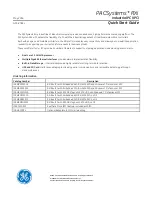
5-111
Maintenance and inspection procedures
(2) Timing belt tension measurement
Rotate the timing pulley A to one direction while visually checking its position, and measure the belt tension at
every 90 degrees, four times in total. The average of the four measurements is used as the timing belt tension
value.
The timing belt must be pulled tight before the tension is measured. For this purpose, rotate the timing pulley A 90
degrees before measurement. Measure the tension of the belt to be pulled by the movement of the timing pulley A.
When the temperature of the robot arm is high, the timing belt tension is increased. To ensure reliability of the
measurement, take measurements at least 30 minutes after the robot stops its movement.
Low ambient temperature may make accurate measurements using a tension gauge impossible. In this case, per
-
form the automatic operation or jog operation at measuring target axis for a few minutes, then measure the ten
-
sion of the belt.
Fig.5-12 : Timing belt tension measurement
The procedure is shown below.
1) Turn on the controller's power supply.
2) Rotate the timing pulley A to one direction in jog operation while visually checking its position, and measure
the belt tension at every 90 degrees, four times in total (for one turn of the timing pulley A).
The amount of movement of each axis when the timing pulley A is rotated 90 degrees are shown in
126, "(13) Amount of movement of each axis during the timing belt tension measurement"
.
3) Take an average of the four measurements to determine the timing belt tension value.
During inspection of the timing belt, check that the belt tension exceeds the replacement guideline value in
Page 125, "(12) Timing belt tension"
. When the belt tension value becomes less than the guideline value,
the belt must be replaced immediately.
䝍䜲䝭䞁䜾䝥䞊䝸 㻭
㻥㻜㼻䛪䛴ື䛛䛩䚹
䝥䞊䝸䛻ᕳ䛝ྲྀ䜙䜜䜛ഃ䛾䝧䝹䝖
䝍䜲䝭䞁䜾䝥䞊䝸 㻮
ᙇຊィ
䝍䜲䝭䞁䜾䝧䝹䝖
㼀㼕㼙㼕㼚㼓㻌㼜㼡㼘㼘㼑㼥㻌㻭
㻾㼛㼠㼍㼠㼑㻌㼍㼠㻌㼑㼢㼑㼞㼥㻌㻥㻜㻌㼐㼑㼓㼞㼑㼑㼟㻚
㻮㼑㼘㼠㻌㼠㼛㻌㼎㼑㻌㼣㼛㼡㼚㼐㻌㼍㼞㼛㼡㼚㼐㻌㼠㼔㼑㻌㼜㼡㼘㼘㼑㼥
㼀㼕㼙㼕㼚㼓㻌㼜㼡㼘㼘㼑㼥㻌㻮
㼠㼑㼚㼟㼕㼛㼚㻌㼓㼍㼡㼓㼑
㼀㼕㼙㼕㼚㼓㻌㼎㼑㼘㼠
















































